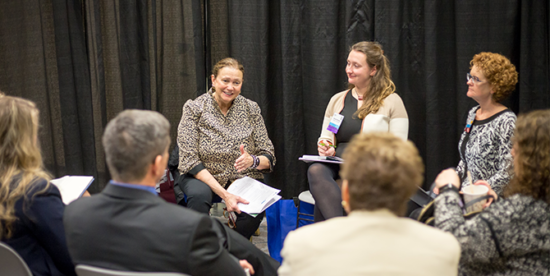By Lizette Corro, President and CEO of Corro Nobil Associates

Lizette (left) delivers an education session on fundraising at the 2019 National Meeting. Photo credit: A.E. Landes Photography
Editor’s note: At the 2019 Global Ties U.S. National Meeting, Lizette Corro delivered a session on Event-Driven Fundraising. This article presents some of the content from the session.
Step 1: Why a Fundraiser?
The first step to creating a successful fundraiser is to answer the question “Why is your organization planning a fundraiser?” Is it to:
- Raise unrestricted funds?
- Raise funds for a specific program?
- Initiate a new program?
- Raise both funds and awareness?
- Engage new donors and inspire existing donors?
- Meet an event goal outlined in the strategic plan?
Step 2: Revenue Goals
Once the purpose is decided, the fun begins. Set a realistic revenue goal based on past achievements and the existing donor pool. The criteria for establishing an achievable fundraising goal should include:
- Number of projected attendees
- Cost of event tickets and sponsorship levels
- Other ideas to bring in revenue – live/silent auction, text to pledge, fund a program, etc.
Step 3: Tracking Budget & Expenses
Establish an expense budget to track all costs. When managing the budget, always round up costs to leave wiggle room—managing a surplus is much easier than managing a deficit. Don’t forget your invisible costs, such as staff time spent on the event instead of their day-to-day activities.
Step 4: Venue and Date
Find the perfect venue and set a date. Finding a venue early is important, because it establishes both “the when” and “the where” for your event. Think ahead on potential dates where your major donors, honorees, board and committee members can attend. Consider easily-accessible venues, and ensure that the date does not fall within any culturally significant holidays that would prevent people from attending.
Step 5: Establish Committees
With a venue and date now selected, it’s time to assemble the volunteer committees who will serve as the backbone of the event. The key committees to ensure fundraising success are the Fundraising and Sponsorship Committees.
The roles for each committee and its members should be clear and specific. For instance, the Fundraising Committee should work with staff to meet overall fundraising goals by increasing ticket sales, sponsorships, and other revenue-generating activities.
The Sponsorship Committee is key to achieving the revenue goal. Its role includes:
- Collaborating with the Fundraising Committee and staff.
- Creating a timeline for securing sponsorships.
- Managing the development of sponsorship packets, letters, and messaging to engage supporters and inspire donors to give.
- Reaching out to donor base, board members, members of other committees, friends, colleagues, vendors, businesses.
- Asking each stakeholder for additional names in their network that may be interested in your mission.
- Researching businesses that may be interested in your mission.
- Handling solicitation of all potential sponsorships and manages those relationships.
- Securing sponsorship and in-kind donations.
- Following up with solicitations sent for feedback and questions.
- Ensuring all sponsor commitments are met before, during, and after the event.
Step 7: Post-Event Follow Up
This is as important as the time spent on the event itself, as it relates to donors and those who attended. Each attendee should receive a note of thanks; sponsors should receive a thank you note, as well as a photo of them from the event and a request for a call or a meeting to talk about the event’s success, how the event’s funds are helping your organization’s mission, and prime them for the next event.
Sponsors should be engaged throughout the year. Consider visiting an organization’s site or program, or have the executive director or a board member call sponsors with progress on the initiatives they were interested in. It will be so much easier to secure their support at the next fundraiser if they are engaged and inspired by your mission.
If you stay the course on these basic steps, your event will meet and hopefully exceed its financial goal.
For more advice from Lizette, contact her at lizette@corronobilassociates.com
